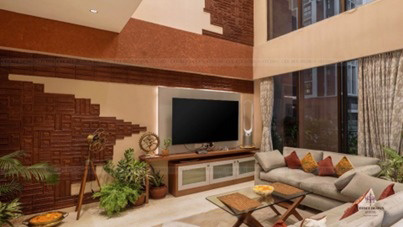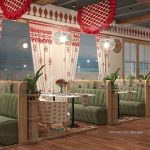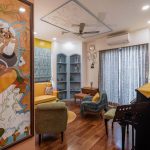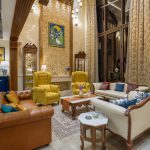- Home Owner Bangalore -
- Home Owner Kolkata -
- Other Enquiry -
What makes an Interior Truly Eco Friendly?

We’ve all heard terms like “sustainable design” and “eco-friendly interiors” thrown around, but what do they really mean? Is it just about adding plants and cane furniture? Not quite.
Eco-friendly interiors are all about designing homes that are good for the planet and healthy for us. This means using natural materials like bamboo, rattan, jute, lime, or khadi, reusing what we can, and planning spaces that allow natural light and airflow.
It’s about being thoughtful…choosing what lasts, what supports local artisans, and what reduces waste.
In Indian homes, where tradition and sustainability have always gone hand in hand, we already have a rich design heritage that supports eco-conscious living. We just have to bring them together thoughtfully!
Want to know where to begin? Start here!
Start with Local Materials: Embrace the Native
One of the most effective ways to make a home eco-friendly is to use locally sourced, natural materials. Not only does this reduce the carbon footprint associated with transportation, but it also supports local artisans and traditional craftsmanship.

• Rattan, Jute & Khadi :
If you’re into breathable spaces with a raw, earthy vibe…this one’s for you.
Think rattan wardrobes, jute rugs, and khadi curtains + handblock print cushions. These aren’t just biodegradable…they breathe, age beautifully, and give off major “slow living” energy.

• Terracotta :
This timeless clay material can be used for flooring, wall accents, planters, and even lighting, gives your space warmth, texture, and that subtle luxe-feel without trying too hard.It stays cool in the summer and brings a sense of warmth and grounding. (Jyotsna client’s terracotta wall )
In one of our Kolkata projects, we designed a double-height living room with a full terracotta feature wall for our client. Paired with massive sliding windows, the space stayed naturally cool, breezy, and seriously stunning…no AC needed most days.
Terracotta is super breathable, regulates indoor temps like a pro, and always brings that rustic-modern balance. Think of it as skincare, but for your home!
Our Local Love!
We love working with local artisans like the terracotta artists from Bishnupur. In many projects we use rattan, jute and handwoven fabrics instead of mass-produced stuff. Why import when our own craft heritage is so strong?

• Terracotta :
This timeless clay material can be used for flooring, wall accents, planters, and even lighting, gives your space warmth, texture, and that subtle luxe-feel without trying too hard.It stays cool in the summer and brings a sense of warmth and grounding. (Jyotsna client’s terracotta wall )
- Refurbishing old furniture
- Repurposing old saris or handloom fabrics as curtains, cushions, or wall hangings
Energy-Efficient Fixtures and Appliances
This goes without saying, but still gets overlooked. Use:
- LED lighting instead of incandescent or CFLs
- Solar water heaters or solar panels for powering at least a portion of your home
- Energy-efficient ceiling fans (very relevant in Indian homes!) and appliances with a high BEE star rating
These choices reduce your electricity bills and your carbon footprint in the long run.
Indoor Plants: Nature’s Air Purifiers
No eco-friendly home is complete without greenery. Plants not only purify indoor air but also create a calm, vibrant atmosphere. Go for hardy, low-maintenance Indian varieties like:
- Areca palm
- Snake plant
- Money plant
- Aloe vera
Pair them with terracotta or reclaimed wood planters for added earthiness!
Eco-Friendly Can Be Extra Creative
Sustainable doesn’t have to mean minimalist or boring. It can be bold, expressive, and fun especially when you work with natural materials in unexpected ways.

Bamboo Ceiling? Yes, Please.
One of our favorite balcony spaces had this fun feature: real bamboo sticks with lights inside. It’s sustainable and has a vibe. You don’t need a fancy chandelier when nature’s got your back! Functional and magical.


In one of our projects instead of opting for a laminate shutter, we used woven rattan panels framed in wood. Rattan is biodegradable, fast-growing, and incredibly elegant. It lent the room a soft, natural touch that laminate or glossy finishes could never offer.
In another home, we extended this idea to the ceiling. A detailed rattan ceiling design added texture without overwhelming the space. It was timeless, breathable, and sustainable all in one move.

Global Inspiration:

- Ilse Crawford (UK)
Known for: Human-centered design with a focus on natural materials, sustainability, and emotional well-being.
Her interiors often feature untreated wood, natural textiles, and light-maximizing layouts.

- Jeanne Gang (USA)
Architect and sustainability advocate.
Known for: Using recycled materials and designing buildings with passive ventilation and green roofs.

Studio Mumbai (India-based but internationally acclaimed) led by Bijoy Jain
Known for: Combining traditional Indian craftsmanship with sustainable architecture using earth, wood, brick, and lime.
Eco-Friendly Isn’t Just a Vibe…It’s a Lifestyle
Eco-friendly interiors aren’t just a vibe, they’re a mindset. Think of it like this: instead of buying a mass-produced plastic planter from a big-box store, imagine sipping chai on your balcony with a leafy money plant growing in a hand-thrown terracotta pot made by a local artisan. One looks trendy, the other feels like home and actually makes a difference.
It’s not about having an “aesthetic” pinterest-worthy space, it’s about choosing better, slower, and smarter. Use khadi curtains that your nani would approve of. Let sunlight in instead of switching on 5 lights at noon. Restore your dad’s old study table with a fresh coat of eco-friendly polish and give it a second life.
Small swaps. Local love. Long-term mindset.
That’s what makes a space truly eco-friendly.
How to Make Sure It’s Actually Eco-Friendly
Want to be sure what you’re buying is truly sustainable and not just marketing hype? Look out for these labels and certifications:
- BEE Star Ratings – for energy-efficient appliances
- FSC-certified wood – ensures the wood is from responsibly managed forests
- OEKO-TEX or GOTS – for organic, chemical-free fabrics
- Low-VOC Paints – like Asian Paints Royale Atmos, better for your health and indoor air
These small checks help you make smarter, cleaner choices for your home and the planet.
FAQs
Q1. Are eco-friendly interiors more expensive?
Not always! While some natural materials can be costlier upfront, many sustainable choices, like using local materials, restoring old furniture, or maximizing natural light, can actually reduce costs in the long run.
Q2. Can I still have a modern-looking home if I go eco-friendly?
Absolutely. Sustainability and style can go hand-in-hand. Many modern interiors today use earthy tones, natural textures, and minimal waste design, which are all eco-friendly too.
Q3. What is the easiest eco-friendly swap to start with?
Start small: switch to LED lights, add a few indoor plants, or use cotton/khadi curtains. Every choice counts.
Q4. What are some Indian materials that are eco-friendly and beautiful?
Rattan, jute, terracotta, bamboo, lime plaster, cane, reclaimed wood, khadi, and handloom textiles, all eco-conscious and full of character.
Q5. Does using indoor plants really improve air quality?
Yes! Plants like snake plant, money plant, aloe vera, and areca palm help purify indoor air by absorbing toxins and releasing oxygen.
Q6. Is going eco-friendly just a trend?
It’s more than a trend, it’s the future. Sustainability is becoming the foundation of good design, not just a passing aesthetic.
Q7. Is it okay to mix traditional and modern styles while going eco-friendly?
Definitely! That’s where the magic happens. Blend traditional materials like terracotta, rattan, or khadi with clean, modern lines and neutral palettes. You get the best of both worlds—style and sustainability.
Q8. Do eco-friendly homes have to look earthy or rustic?
Nope. That’s a myth. Eco-friendly interiors can be minimal, boho, Japandi, or even maximalist. It’s all about your material choices!
Similar Projects:
Follow us on:
About us
CeeBeeDesignStudio is a top-tier interior design consultancy, excelling in Interior Decoration and Turn Key Execution of Interior Works. With a strong presence in Kolkata and Bangalore, we have transformed over 1000+ residential projects and 300+ commercial spaces. Our team’s commitment to excellence and innovation ensures a remarkable design experience for every client.
 Cafe Interiors! Here’s Everything You Need to Know
Cafe Interiors! Here’s Everything You Need to Know Embracing Kerala Style Interior Design: A Timeless Blend of Heritage and Elegance
Embracing Kerala Style Interior Design: A Timeless Blend of Heritage and Elegance Boho Interior Designer: How to Hire the Perfect Expert for Your Dream Space
Boho Interior Designer: How to Hire the Perfect Expert for Your Dream Space Turnkey Interior Design : Seamless, Stress-Free, and Stunning Solutions
Turnkey Interior Design : Seamless, Stress-Free, and Stunning Solutions The Art of Bungalow Interior Design
The Art of Bungalow Interior Design
Enter Your Details
About Us
CeeBeeDesignStudio is one of the fastest growing interior execution companies. Currently we have very strong presence in Bangalore, Goa, and Kolkata. Our motto is to keep the clients requirement and budget in mind and give a qualitative result on time.
Quick Link
Contact Info
- Door No-18, 3rd B Cross, Domlur II Stage, Bangalore 560071
- +91 8697306015
- chitralekha@ceebeedesignstudio.com
Contact Info
- 3045 Rajdanga main road, Kolkata, West Bengal 700107
- +91 8697306015
- chitralekha@ceebeedesignstudio.com
- Copyrigt © 2025 CeeBeeDesignStudio Pvt. Ltd



